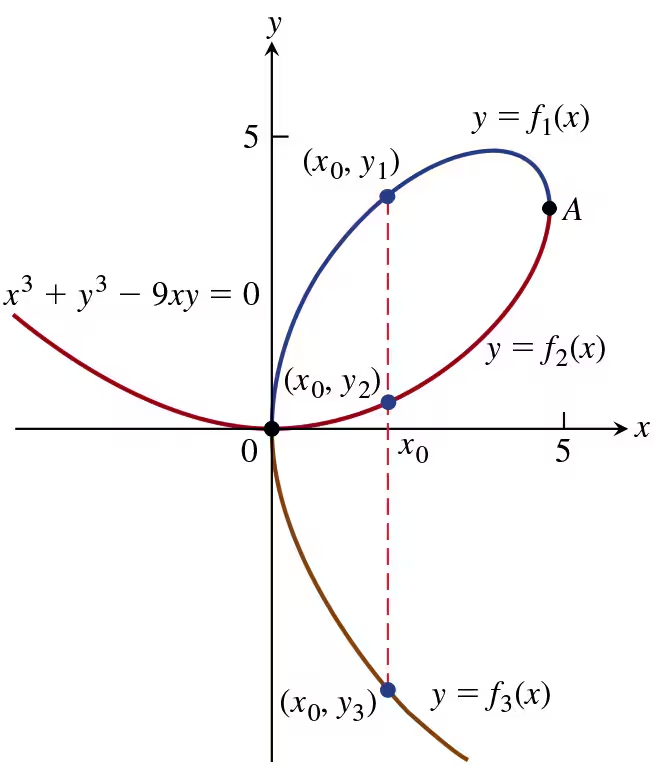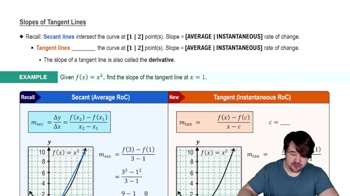Parallel tangent lines Find the two points where the curve x² + xy + y² = 7 crosses the x-axis, and show that the tangent lines to the curve at these points are parallel. What is the common slope of these tangent lines?
Table of contents
- 0. Functions7h 54m
- Introduction to Functions16m
- Piecewise Functions10m
- Properties of Functions9m
- Common Functions1h 8m
- Transformations5m
- Combining Functions27m
- Exponent rules32m
- Exponential Functions28m
- Logarithmic Functions24m
- Properties of Logarithms36m
- Exponential & Logarithmic Equations35m
- Introduction to Trigonometric Functions38m
- Graphs of Trigonometric Functions44m
- Trigonometric Identities47m
- Inverse Trigonometric Functions48m
- 1. Limits and Continuity2h 2m
- 2. Intro to Derivatives1h 33m
- 3. Techniques of Differentiation3h 18m
- 4. Applications of Derivatives2h 38m
- 5. Graphical Applications of Derivatives6h 2m
- 6. Derivatives of Inverse, Exponential, & Logarithmic Functions2h 37m
- 7. Antiderivatives & Indefinite Integrals1h 26m
- 8. Definite Integrals4h 44m
- 9. Graphical Applications of Integrals2h 27m
- 10. Physics Applications of Integrals 3h 16m
- 11. Integrals of Inverse, Exponential, & Logarithmic Functions2h 31m
- 12. Techniques of Integration7h 41m
- 13. Intro to Differential Equations2h 55m
- 14. Sequences & Series5h 36m
- 15. Power Series2h 19m
- 16. Parametric Equations & Polar Coordinates7h 58m
4. Applications of Derivatives
Implicit Differentiation
Problem 3.7.46c
Textbook Question
The folium of Descartes (See Figure 3.27)
c. Find the coordinates of the point A in Figure 3.29 where the folium has a vertical tangent line.

 Verified step by step guidance
Verified step by step guidance1
The folium of Descartes is given by the equation \(x^3 + y^3 - 9xy = 0\). To find where the curve has a vertical tangent, we need to find where the derivative \(\frac{dy}{dx}\) is undefined.
Implicitly differentiate the equation \(x^3 + y^3 - 9xy = 0\) with respect to \(x\). This involves using the chain rule for \(y^3\) and the product rule for \(-9xy\).
After differentiating, you will get an expression for \(\frac{dy}{dx}\). Set the denominator of this expression to zero to find where the derivative is undefined, indicating a vertical tangent.
Solve the resulting equation for \(x\) and \(y\) to find the coordinates of the point(s) where the tangent is vertical.
Substitute the values of \(x\) and \(y\) back into the original equation to verify that they satisfy the folium of Descartes equation, confirming the point A where the tangent is vertical.
 Verified video answer for a similar problem:
Verified video answer for a similar problem:This video solution was recommended by our tutors as helpful for the problem above
Video duration:
7mPlay a video:
Was this helpful?
Key Concepts
Here are the essential concepts you must grasp in order to answer the question correctly.
Vertical Tangent Line
A vertical tangent line occurs at a point on a curve where the slope of the tangent approaches infinity. This typically happens when the derivative of the function is undefined or infinite at that point. In the context of the folium of Descartes, finding the coordinates of point A involves determining where the derivative of the curve is undefined, indicating a vertical tangent.
Recommended video:

Slopes of Tangent Lines
Implicit Differentiation
Implicit differentiation is a technique used to differentiate equations that define y implicitly in terms of x, rather than explicitly as y = f(x). For the folium of Descartes, which is defined by the equation x³ + y³ - 9xy = 0, implicit differentiation allows us to find dy/dx, the slope of the tangent line, at any point on the curve, including where it is vertical.
Recommended video:

Finding The Implicit Derivative
Folium of Descartes
The folium of Descartes is a specific type of algebraic curve defined by the equation x³ + y³ - 9xy = 0. It has a distinctive shape and features, including points where the tangent lines can be vertical. Understanding the properties of this curve is essential for analyzing its behavior and finding points of interest, such as point A with a vertical tangent.

 5:14m
5:14mWatch next
Master Finding The Implicit Derivative with a bite sized video explanation from Patrick
Start learningRelated Videos
Related Practice
Textbook Question
